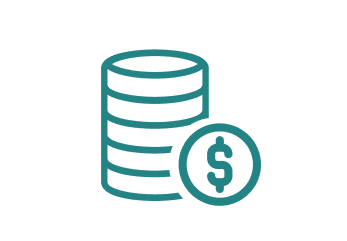Managing bad debt expenses is a significant challenge for many businesses when internal teams are overwhelmed and struggling to keep up with receivables. While it’s common to attribute bad debt to customer insolvency or late payments, often, the bigger issue lies with the pressures facing your accounting staff and inefficiencies in collections processes. These factors can unwittingly escalate financial losses.
By adopting a proactive approach to manage your receivables, which includes leveraging outsourced solutions, automation and expert guidance, you can significantly mitigate the impact of bad debt. This proactive stance not only helps streamline your collections process but also supports your team in maintaining a healthy financial status.
What Happens If You Let Bad Debt Persist?
Bad debt expense is the amount of uncollectible accounts receivable that a company writes off during a specific period. This is the result of receivables that are no longer reasonably collectible.
Bad debt expenses can have a significant impact on a company’s financial health, such as:
- Direct financial loss that reduces revenue and profitability.
- Cash flow disruption that hinders your ability to meet financial obligations or seize opportunities for growth.
- Increased operational costs from putting more time and resources to managing the collections process.
- Inaccurate financial reporting that leads to misallocation of resources.
- Strained relationships with late or non-paying customers that hurt future sales.
- Reduced borrowing capacity due to high levels of bad debt.
How to Estimate & Track Potential Losses
Estimating and calculating your company’s bad debt expenses for a given period allows your business to better manage risk, deduct more from taxes and better budget or forecast cash flow.
Recording Bad Debt
Your business will record bad debt based on one of two methods: the direct write-off method or the allowance method.
- The direct write-off method records bad debt once an invoice is confirmed as uncollectible. Because the full expense is not recognized during the same period as the sale, this can be an issue for GAAP-compliant companies that use the accrual accounting method.
- The allowance method estimates anticipated uncollectible accounts for each accounting period and creates an allowance for these accounts under a contra-asset account against accounts receivable. This method allows you to record the amount that is expected to be uncollectible ahead of time.
How to Estimate Bad Debt
Businesses can estimate their bad debt through several methods, but most common are the sales percentage method and the accounts aging method.
To use the sales percentage method:
- Determine the total credit sales for the period.
- Estimate the percentage of credit sales that will become uncollectible based on historical data or industry averages.
- Divide your estimated total of bad credit by your total credit sales.
- Multiply the total credit sales by the estimated bad debt percentage to calculate the bad debt expense.
For example, if a company has $1M in credit sales and estimates that 2% of those sales will become uncollectible, the bad debt expense would be $1M multiplied by 0.02, equalling $20,000 in bad debt.
To use the accounts aging method, consider a hypothetical company and its accounts receivable aging schedule along with percentages typically attributed as bad debt. Aging accounts are categorized by age and multiplied by the assumed percentage of uncollectible debt.
- 0-30 days: $100,000 (1% estimated to be uncollectible)
- 31-60 days: $50,000 (3% estimated to be uncollectible)
- 61-90 days: $30,000 (5% estimated to be uncollectible)
- Over 90 days: $20,000 (10% estimated to be uncollectible)
To calculate the bad debt estimate, follow these steps:
- 0-30 days: $100,000 x 1% = $1,000
- 31-60 days: $50,000 x 3% = $1,500
- 61-90 days: $30,000 x 5% = $1,500
- Over 90 days: $20,000 x 10% = $2,000
Total estimated bad debt: $1,000 + $1,500 + $1,500 + $2,000 = $6,000
Go From Reporting Bad Debt to Managing It
Use your financial statements not just to identify the impact of bad debt, but also to proactively analyze trends in your receivables function. Companies should regularly employ key financial ratios and metrics to gauge the health of their receivables function. Metrics such as Days Sales Outstanding (DSO), Receivables Turnover Ratio and other ratios offer a clear view of how effectively a business is managing its credit and collections processes. Monitoring these indicators helps in optimizing cash flows and enhancing financial stability.
While customer insolvency is a known risk for bad debt, the more insidious and controllable factors contributing to bad debt expenses often lie within your company’s own processes. Inefficient collections practices, such as delayed invoicing, lack of follow-up and inadequate documentation, can lead to a backlog of unpaid receivables.
Additionally, overwhelmed accounting teams may struggle to keep up with the volume of collections tasks, leading to further delays and missed opportunities to recover outstanding balances.
4 Ways to Minimize Bad Debt Expenses
While you can’t control the solvency of your customers—though you can implement credit checks—you can take proactive steps to keep collections efficiently moving.
These steps can aid in both securing collections and minimizing the time and resources you need to manage receivables.
- Evaluate outsourced solutions: Outsourcing receivables to part-time accounting experts provides your business with specialized knowledge and resources to improve collections efficiency and reduce bad debt. These professionals have the experience and tools to navigate the collections process effectively and open up more time to focus on core business functions.
- Consider receivables factoring or financing: Receivables factoring and financing can help businesses manage cash flow and minimize bad debt by selling outstanding invoices to a third-party factor at a discount. While these financial tools can provide immediate relief in the short-term, it’s essential to understand the associated costs and potential pitfalls. Fractional expertise can further help businesses navigate these options and make informed decisions.
- Automate processes to avoid future delays: Automation can streamline invoicing and collections processes, minimizing error and ensuring prompt collections. Tools such as automated invoicing systems, payment reminders and electronic documentation can help businesses stay on top of receivables and avoid delays that contribute to bad debt. Even ready-to-use AI-enabled tools can help you automate receivables processes and forecast changes faster.
- Implement upfront collections strategies: Many companies require an upfront deposit or provide discounts for early payment. Regardless of the incentive or requirement you implement, it’s essential to make your payment terms as clear as possible to your customers.
Streamline Your Collections With Outsourced Expertise
By implementing a comprehensive strategy, businesses can transform their collections practices and minimize bad debt expenses. If your bad debt is as much related to your internal processes as it is your customers, you need a solution that eases the burden on your team.
Paro’s flexible accounting solutions can provide your business with a fractional expert or team of experts who specialize in receivables. Not only will your business spend less time managing overdue collections, you can also match with expertise that understands how to implement new procedures and systems for greater efficiency. Schedule a consultation to learn more about our solutions.







